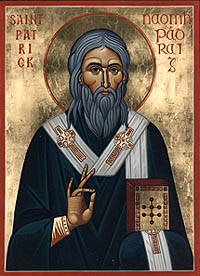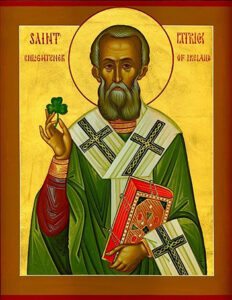St Patrick, Enlightener of Ireland – Mar 17 I The Apostle of the Irish

Saint Patrick was born around 385/387, in the village of Bannavem Taberniae, in a part of Britain now known as Wales. His name Latin Patricius, meaning high-born. His parents were part of the Christian minority of Britain; his father, Calpurnius, was a deacon and a Roman county decurion (tax official), the son of Potitus, a priest, of the village Bannavem Taburniæ. His parents were among the very few Christians in Britain, where pagan gods were widely worshipped. Patrick, lived in the village of Bannavem Taberniae, at the time when Christian missionaries were sent to many parts of Europe, and the western Church was slowly working in the isolated islands of the British Isles.
Patrick was not particularly religious or scholarly, but lived a quiet life. St Patrick, at the age sixteen was captured and seized from his native Britain by a raiding party of Irish marauders and taken to Ireland and sold as a slave to herd, to tend sheep on a lonely mountain in Slemish, County Antrim. During that time, Patrick learned the language of his captors, and used his solitude to find God and the faith of his youth, discovering that he was indeed not alone. Thus, in his captivity he came for the first time to have a true faith in God and seeking out the Lord with his whole heart and praying frequently. In his Confession, the testament he wrote towards the end of his life, he says, “After I came to Ireland — every day I had to tend sheep, and many times a day I prayed — the love of God and His fear came to me more and more, and my faith was strengthened. And my spirit was so moved that in a single day I would say as many as a hundred prayers, and almost as many at night, and this even when I was staying in the woods and on the mountain; and I would rise for prayer before daylight, through snow, through frost, through rain, and I felt no harm.”

After six years of slavery in Ireland, at the age of 22, he was guided by God in a vision to make his escape. He escaped, walking 200 miles to a ship and returning to England and afterwards St Patrick sought clerical training, in the monastic life in Aesir in Gaul, present day France, under the guidance of the holy Bishop Germanus. Many years later he was ordained bishop. In a dream, he saw the people of Ireland calling him, “We beg you, holy youth, that you shall come and shall walk again among us.” and he was sent to Ireland once again, about the year 432, to convert the Irish to Christ. His arduous labours bore so much fruit that within seven years, three bishops were sent from Gaul to help him shepherd his flock, ‘my brethren and sons whom I have baptized in the Lord — so many thousands of people,’ he says in his Confession. Thus, St. Patrick was sent to Ireland twice, first against his will, and the second time following the will of God.
There, he preached the Gospel, reaching tribal chieftains, and sought their permission to teach their subjects also. He established an episcopal administration and led a monastic lifestyle, establishing Christianity in Ireland. His apostolic work was not accomplished without much ‘weariness and painfulness,’ long journeys through difficult country, and many perils; he says his very life was in danger twelve times. When he came to Ireland, as its enlightener, it was a pagan country; when he ended his earthly life some thirty years later, about 461, the Faith of Christ was established in every corner.” – Great Horologion.
The work of St Patrick and his brethren has been called the most successful single missionary venture in the history of the Church. It is said of St Patrick that he chanted the entire Psalter every day. Saint Patrick wrote this semi-autobiography as a labor for God, explaining the story of his life to inspire others to believe and turn their lives to God. Additionally, he wished to address concerns his fellow clergy had about his holding the office of bishop. Saint Patrick wrote this letter to the soldiers of King Coroticus to chastise them for capturing Christians of Patrick’s flock as slaves. St. Patrick put the great commission of Jesus into practice as a missionary to Ireland in the 5th century. He explained the holy trinity to the Irish by using something very common and is most often recognized for likening the Trinity to a shamrock, illustrating that the shamrock has three parts, and yet is one; the three leaves, growing from a single stem, helped the Irish people see the mystery of the Holy Trinity. in a similar way, the Trinity has three persons, and is still one God.

Bishop Patrick tirelessly prayed and continued his work, establishing churches and monasteries, including his episcopal See in Armagh in 444. His writings include several letters and confessions. He worked with countless young people, and bravely denounced a leader who had enslaved some members of the Christian community. He is perhaps best known for defeating the pagan leaders, ordaining priests and bishops to serve his people, and baptizing thousands. St. Patrick died at Saul, Downpatrick, Ireland, on March 17, 461. His feast day is March 17. It is recorded that the beloved missionary was buried at Saul, the site of his first church. A granite monument was placed in Downpatrick, in 1899.
0 Comments